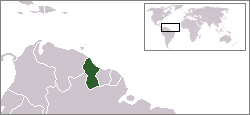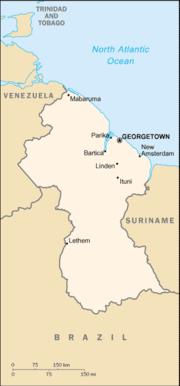Guyana
|
|
The Co-operative Republic of Guyana is a nation along the northern coastline of South America. It constitutes the western part of the wider region of Guiana (an Amerindian word meaning Land of Many Waters), and is bordered to the east by Suriname, to the south by Brazil, to the west by Venezuela and to the north by the Atlantic Ocean. The border with Venezuela is one that is disputed, as is the most southern part of the border with Suriname (upper Corentyne river).
| ||||
| National motto: One People, One Nation, One Destiny | ||||

| ||||
| Official language | English | |||
| Capital | Georgetown | |||
| President | Bharrat Jagdeo | |||
| Prime Minister | Sam Hinds | |||
| Area - Total - % water | Ranked 81st 214,970 km² 8.4% | |||
| Population
| Ranked 156th
| |||
| Independence
| From the United Kingdom | |||
| Currency | Guyanese dollar | |||
| Time zone | UTC -4 | |||
| National anthem | Dear Land of Guyana, of Rivers and Plains | |||
| Internet TLD | .gy | |||
| Calling Code | 592 | |||
| Contents |
History
Main article: History of Guyana
At the time the first Europeans arrived in the area around 1500, Guyana was inhabited by Arawak and Carib tribes of Amerindians. European settlement began in the early 17th century with the Dutch, who established three separate colonies; Essequibo (1616), Berbice (1627), and Demerara (1752). The British assumed control in the late 18th century and were finally ceded the area in 1814. The three became a single British colony known as British Guiana in 1831.
The abolition of slavery in 1834 led to black settlement of urban areas and the importation of indentured labourers from India, China and Portugal to work the sugar plantations. This ethnocultural divide has persisted and has on occasion led to turbulent politics. Guyana achieved independence from the United Kingdom in 1966 and became the Cooperative Republic in 1970, remaining a member of the Commonwealth.
Leaders
- Cheddi Jagan 1957 - 1964, 1992 - 1997
- Forbes Burnham 1966 - 1985
- Desmond Hoyte 1985 - 1992
- Janet Jagan 1997 - 1999
- Bharrat Jagdeo 1999 - Present
Politics
Main article: Politics of Guyana
Legislative power rests in the unicameral Guyanese parliament, the National Assembly, with 53 members chosen on the basis of proportional representation from national lists named by the political parties. An additional 12 members are elected by regional councils at the same time as the National Assembly.
Executive authority is exercised by the president, who appoints and supervises the prime minister and other ministers. The president is not directly elected; each party presenting a slate of candidates for the assembly must designate in advance a leader who will become president if that party receives the largest number of votes. Any dissolution of the assembly and election of a new assembly can lead to a change in the assembly majority and consequently a change in the presidency.
The highest judicial body is the Court of Appeal, headed by a chancellor of the judiciary. The second level is the High Court, presided over by a chief justice. The chancellor and the chief justice are appointed by the president.
Guyana is a full & participating member of the Caribbean Community (CARICOM).
Regions
Main article: Regions of Guyana
Guyana consists of 10 regions:
- Barima-Waini
- Cuyuni-Mazaruni
- Demerara-Mahaica
- East Berbice-Corentyne
- Essequibo Islands-West Demerara
- Mahaica-Berbice
- Pomeroon-Supenaam
- Potaro-Siparuni
- Upper Demerara-Berbice
- Upper Takutu-Upper Essequibo
Geography
Main article: Geography of Guyana
The Guyanese landscape can be roughly divided into three regions: a narrow, marshy plain along the coast of the Atlantic Ocean, a white sand belt more inland containing rainforests and most of Guyana's mineral deposits, and finally the larger interior highlands consisting mostly of savannas and mountains, the highest being Mount Roraima at 2,835 m. Major rivers include the Essequibo, the Demerara, the Corentyne and the Berbice.
The local climate is tropical and generally hot and humid, though moderated by northeast trade winds along the coast. There are two rainy seasons, the first from May to mid-August, the second from mid-November to mid-January.
Economy
Main article: Economy of Guyana
The Guyanese economy has exhibited moderate economic growth since 1999, based on an expansion in the agricultural and mining sectors, a more favourable atmosphere for business initiatives, a more realistic exchange rate, fairly low inflation, and the continued support of international organisations. Chronic problems include a shortage of skilled labour and a deficient infrastructure. The government is juggling a sizable external debt against the urgent need for expanded public investment. Low prices for key mining and agricultural commodities combined with troubles in the bauxite and sugar industries threaten the government's already tenuous fiscal position and dim prospects for the future.
Demographics
Main article: Demographics of Guyana
Guyana has a diverse ethnic population: the three major groups are the (East) Indians or Indo-Guyanese (50%) who have remained predominantly rural, the Africans or Afro-Guyanese (36%) who constitute the majority urban population, and the Amerindians (7%) who live in the country's interior. Chinese and Europeans (mostly Portuguese (Guyana) and British) and those of mixed origins make up the remainder.
Christianity (50%), Hinduism (35%), and Islam (10%) are the dominant religions in Guyana, with the latter two concentrated in the Indo-Guyanese community. Ninety percent of the inhabitants live on the narrow coastal plain, where population density is more than 115 persons per km².
Emigration has been a large and persistent problem in Guyana. Since independence, as many as 10,000 Guyanese would leave and settle permanently in the United States alone every single year (and this doesn't take into account departures for Canada or Britain), and demand to emigrate remains very high. Many in the government worry that the country may become depopulated, but few concrete steps have been taken to stem the outflow.
Culture
Main article: Culture of Guyana
Guyana's culture is very similar to that of the English speaking Caribbean. It is so similar that Guyana is included and accepted as a Caribbean Nation. Only its geographical location separates it from the rest of the English speaking Caribbean. Guyana shares similar interests with these islands in the West Indies, such as food, festive events, music, sports, etc.
Cultural events in Guyana
- Mashramani (Mash)
- Phagwah (Holi)
- Deepavali (Diwali)
- Folk Festival
- The Big Lime
Sports in Guyana The major sports in Guyana are Cricket, Softball Cricket (Beach Cricket) and Football (Soccer). The minor sports in Guyana are netball, rounders, lawn tennis, basketball, table tennis, boxing, and a few others.
| Date | English Name | Remarks |
|---|---|---|
| January 1 | New Year's Day | |
| February 23 | Mashramani-Republic Day | |
| Variable | Phagwah | |
| Variable | Eid-ul-Fitr | |
| Variable | Good Friday | |
| Variable | Easter Monday | |
| May 1 | Labour Day | |
| May 26 | Independence Day | |
| July | CARICOM Day | |
| August 1 | Emancipation Day | |
| Variable | Diwali | |
| December 25 | Christmas | |
| December 26 | Boxing Day |
Military
Military branches: Guyana Defense Force (GDF; includes Ground Forces, Coast Guard, and Air Corps), Guyana People's Militia (GPM), Guyana National Service (GNS), Guyana Police Force
Military manpower - availability:
males age 15-49:
206,199 (2002 est.)
Military manpower - fit for military service:
males age 15-49:
155,058 (2002 est.)
Military expenditures - dollar figure: $7 million (FY94)
Military expenditures - percent of GDP: 1.7% (FY94)
Miscellaneous topics
- Music of Guyana
- Communications in Guyana
- Transportation in Guyana
- Military of Guyana
- Foreign relations of Guyana
See also
References
- Attenborough, David. 1956. Zoo Quest to Guiana. Lutterworth Press, London.
External links
- President of the Co-operative Republic of Guyana - Official Website (http://www.op.gov.gy)
- SDNP Guyana (http://www.sdnp.org.gy) - Guyanese directory and host to ministerial sites
- Guyana News and Information (http://www.guyana.org) - News, history and more info on Guyanese affairs
- Travel to Guyana (http://www.anytravels.com/south_america/guyana/) - information about "Places to go", events, food and culture
- Love to Guyana (http://www.guyana.ro) - Lots of unique Guyanese features. Ecards, games, chat, jokes...
- BBC profile of Guyana (http://news.bbc.co.uk/1/hi/world/americas/country_profiles/1211325.stm)
- Hinduism in Guyana and Suriname (http://www.guyanaundersiege.com/Cultural/Hindus%20of%20South%20America.htm)
- ParikaInternetGroup.org (http://parikainternetgroup.org) - A website by a small community in Guyana
- The Black Magic Lounge (http://www.blackmagic-lounge.com) - Fresh content and unique design like no other Guyanese site:chat, forum, gallery and more
- Guyana and the Environment (http://www.sdnp.org.gy/gallery/mm/) A site with information on Guyana's environment
| Countries in South America |
|---|
| Argentina | Bolivia | Brazil | Chile | Colombia | Ecuador | Guyana | Panama | Paraguay | Peru | Suriname | Trinidad and Tobago | Uruguay | Venezuela |
| Dependencies: Falkland Islands | French Guiana |
| | Missing image Caricom-Flag.png Flag of the Caribbean Community |
|---|---|
| Antigua and Barbuda | Bahamas¹ | Barbados | Belize | Dominica | Grenada | Guyana | Haiti | Jamaica | Montserrat | Saint Kitts and Nevis | Saint Lucia | Saint Vincent and the Grenadines | Suriname | Trinidad and Tobago | |
| Associate members: Anguilla | Bermuda | Cayman Islands | British Virgin Islands | Turks and Caicos Islands | |
| Observer status: Aruba | Colombia | Dominican Republic | Mexico | Netherlands Antilles | Puerto Rico | Venezuela | |
| ¹ member of the community but not the Caribbean (CARICOM) Single Market and Economy. | edit (https://academickids.com:443/encyclopedia/index.php?title=Template:Caricom&action=edit)
|



